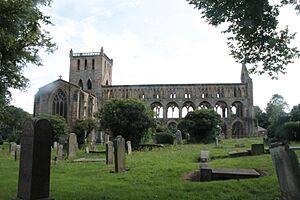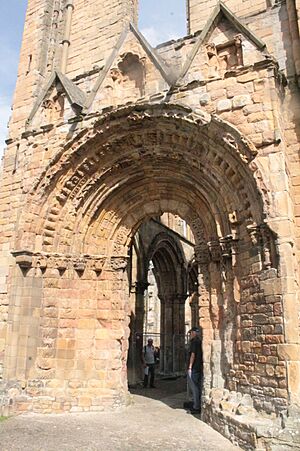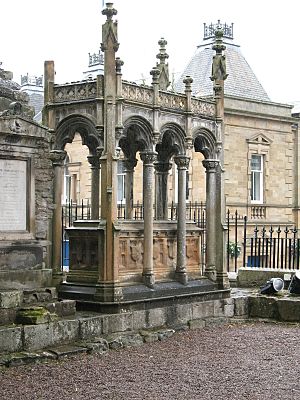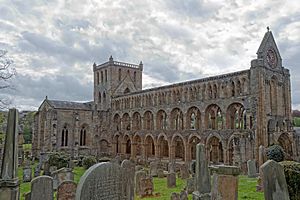Jedburgh Abbey facts for kids
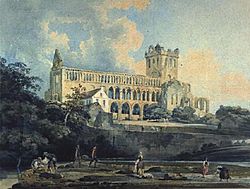
Jedburgh Abbey from the River, a painting from 1798-99 by Thomas Girtin
|
|
| Monastery information | |
|---|---|
| Full name | Jedburgh Abbey |
| Order | Augustinian |
| Established | Ca. 1118 |
| Disestablished | 1560 |
| People | |
| Founder(s) | David I of Scotland |
| Site | |
| Location | Jedburgh, Scottish Borders, Scotland |
| Coordinates | grid reference NT650204 |
| Visible remains | Extensive |
| Public access | Yes |
Jedburgh Abbey is a historic ruined abbey in the town of Jedburgh, Scotland. It was built for Augustinian monks in the 12th century. The abbey is located in the Scottish Borders, about 10 miles (16 km) from the English border. Today, it is a popular tourist attraction known for its beautiful architecture.
Contents
The Abbey's Royal Beginnings
Long before the abbey was built, a church stood in the area. In the 9th century, a bishop named Ecgred of Lindisfarne was given two villages called Gedworth. One of these villages is now the town of Jedburgh.
The story of the abbey we see today began around 1118. Before he became king, Prince David founded a community for a group of monks called Augustinian canons. At first, it was a smaller religious house called a 'priory'.
Around 1147, the priory was upgraded to a full abbey and was dedicated to the Virgin Mary. An abbey is a larger and more important community of monks, led by an abbot.
Grand Construction
The abbey grew in size and importance. The main parts of the church, the nave and the choir, were built in the 13th century. The architecture was a mix of Norman and early English styles, considered some of the best at the time.
The abbey became so important that its abbot was invited to the Scottish Parliament. In 1285, a royal wedding took place here. King Alexander III of Scotland married his second wife, Yolande de Dreux, in the abbey church.
A History of Conflict
Because Jedburgh is so close to England, the abbey was often caught in the middle of wars between Scotland and England.
In 1296, King Edward I of England tried to take control of the abbey. A year later, after the English army was defeated by William Wallace at the Battle of Stirling Bridge, English soldiers attacked and damaged the abbey in revenge.
The abbey was repaired with help from the Scottish king Robert the Bruce. However, it was attacked again by the English in 1346 after the Battle of Neville's Cross. It was damaged several more times in 1410, 1416, and 1464.
In 1523, an English army led by the Earl of Surrey burned the town and the abbey. Twenty years later, in 1544, it was attacked again by the Earl of Hertford. These repeated attacks left the grand abbey in a state of ruin.
The Reformation and a New Role
The final chapter for Jedburgh Abbey as a Catholic monastery came in 1560 with the Scottish Reformation. This was a time when Scotland officially became a Protestant country.
The monks were allowed to stay, but the abbey was no longer a monastery. Instead, the building was used as the local parish church for the new Protestant faith. For safety, the congregation moved into the west end of the nave in 1671.
By 1871, the old abbey building was thought to be unsafe for services, so a new church was built in the town. The owner of the abbey, the Marquis of Lothian, began to preserve the historic ruins. In 1917, the site was given to the state. It is now cared for by Historic Environment Scotland as a scheduled monument.
The monks of Jedburgh Abbey also founded the Jedburgh Grammar School in the late 15th century.
Visiting the Abbey Today
Jedburgh Abbey is one of four famous abbeys in the region. Visitors can explore the stunning ruins and learn about its long history. It is part of a walking route called the Borders Abbeys Way, which also connects to Kelso, Dryburgh, and Melrose.
Notable Burials
Several important people were buried at the abbey over the centuries, including:
- Eadulf Rus
- John Capellanus, Bishop of Glasgow
- Hugh de Roxburgh, Bishop of Glasgow
- Thomas Kerr of Ferniehirst
- Rev Dr Thomas Somerville FRSE, a local minister and writer
Images for kids
See also
 In Spanish: Abadía Jedburgh para niños
In Spanish: Abadía Jedburgh para niños
- Abbot of Jedburgh, for a list of priors, abbots and commendators
- List of places in the Scottish Borders
- List of places in Scotland


